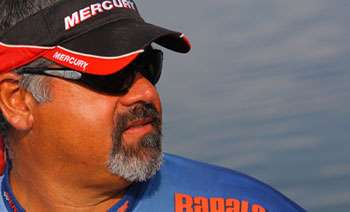
Peter Thliveros and Carolina rigs go together like ham and eggs, Zell Rowland and topwater baits or Denny Brauer and black and blue jigs. But while most anglers associate Carolina rigging with warm weather fishing, Peter T knows it's a rig for all seasons. In fact, he was throwing one in January at the Southern Opens 2008 debut on the St. Johns River.
His win there was the 7th of his impressive BASS career and puts him in the Top 12 in career wins and fourth in career winnings with more than $1.65 million. And while Peter T is a versatile angler with lots of techniques and tools at his disposal, quite a few of those wins and quite a lot of that prize money has come with a Carolina rig as his "go-to" bait.
The Carolina rig has always been respected as a "numbers" method that will catch lots of fish, but Thliveros has shown that it'll catch quality fish, too, using the technique not just to place well in events but also to win them.
One of Thliveros' favorite Carolina rigging techniques utilizes a Zoom Trick Worm behind a Tru-Tungsten sinker (the weight is determined by depth, current, amount of cover and other factors) and Peter T Force Beads.
"My basic Carolina rig consists of an Okuma Nemesis baitcast reel spooled with 17-pound-test Berkley Vanish," he says. "I mount that on a 7-foot Peter T. Carolina rig rod from American Rodsmiths. My leader is usually 12- or 14-pound test Stren fluorocarbon.
"That bait on that rig will catch bass anywhere," he says.
It will even produce finicky Florida bass after a cold front — the conditions Thliveros faced last week on the St. Johns River.
While bass anglers have traditionally used plastic or glass between the sinker and swivel on the Carolina rig, Thliveros prefers the Tru-Tungsten Force Beads.
"One thing I do that's different from most Carolina riggers involves the use of a Tru-Tungsten Peter T Force Bead," Thliveros says. "They're called 'force' beads because they have a strong magnetic field around them — the beads even stick together in your tacklebox. This force attracts bass. Every living thing in the water has a magnetic field around it, and I think the bass know this and use it to identify food."
In addition to creating a fish-attracting racket under the water, the Force Bead will help to protect the knot from the incessant abuse offered by the sinker.
Peter T casts a Carolina rig just about anywhere other anglers will throw anything. He believes the rig offers a natural approach that fools bass anywhere, and he has the track record and bank deposits to prove it.




